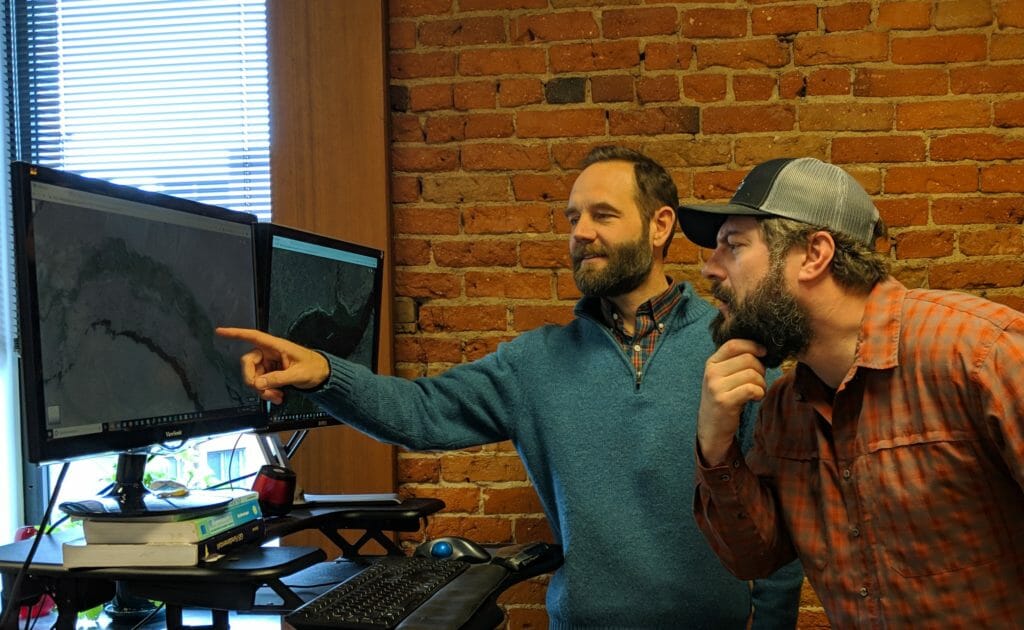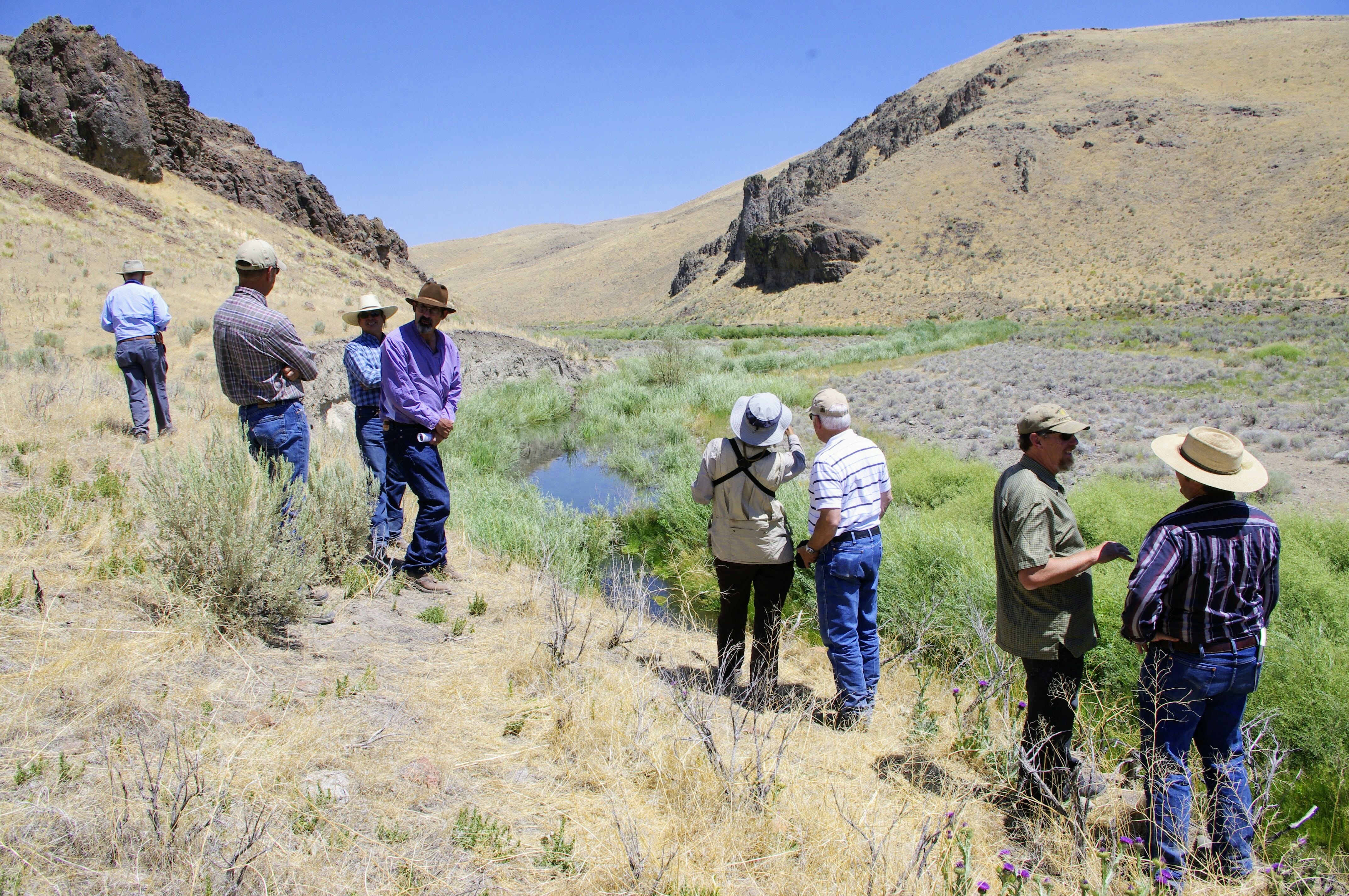Ranchers, Bureau of Land Management staff, and other partners tour Susie Creek in 2012.Photo courtesy Carol Evans/BLM.
If you hang around a Bureau of Land Management biologist near a stream long enough, you are bound to hear the acronym PFC. Proper Functioning Condition is a long-standing rapid assessment the BLM uses to evaluate the overall condition or impairment of streams and streamside vegetation on the 248 million acres the agency manages in the western U.S.
The objective of many BLM management efforts is to shift streams that have been degraded by stressors such as drought, wildfire, and historical grazing practices from a non-functioning designation to a proper functioning designation, and then make sure they stay that way. But how exactly do you do that, especially for such a massive landscape?
Land managers are increasingly turning to two natural approaches to restore degraded riparian areas and improve stream habitats, a one-two punch involving grazing management and beaver. New research led by TU scientists and BLM biologists shows just how effective these can be.
Change in streamside vegetation in response to conservation-oriented livestock grazing and colonization by beaver. Beaver dams are visible as the linear features perpendicular to the stream in the 2013 imagery.
The new study uses satellite imagery to track changes in streamside vegetation over a 30-year period in five watersheds in the Great Basin region of northeastern Nevada and southeastern Oregon. In each watershed, BLM land managers and ranchers who lease BLM lands for grazing made a change in grazing approaches in recent decades.
The approaches varied from place to place, but generally included a mix of exclosures – where some sections of stream are completely fenced off so cattle couldn’t graze – and conservation-oriented grazing regimes – where cattle use shifted from repeated summer-long “hot season” use to “cool season” grazing in spring and fall with periods of rest and rotation. Conservation-oriented grazing approaches are increasingly valued for their ability to allow vegetation to establish and recover from grazing, especially in riparian zones.
“Conservation-oriented grazing is all about timing and intensity,” said Todd Allai, one of the study’s authors and a Natural Resource Specialist with BLM in Vale, Oregon. “The fundamentals are avoiding continuous hot season use and minimizing the time cattle spend in critical habitats like riparian areas.”
Carol Evans, another author of the study, spent much of her 28-year career with BLM working with ranchers to implement conservation-oriented grazing at sites across northeastern Nevada, including Susie Creek, one of the study watersheds.
“Susie Creek showed me the power of natural recovery processes,” Evans said. “Once grazing practices were changed to allow for recovery of riparian plants, we saw willow communities became reestablished, and then beaver showed up.”
Beaver, it turns out, are a big amplifier of the recovery in streamside vegetation, especially in the arid Great Basin. Their dams store water and re-wet floodplains, keeping water from running off downstream and providing moisture for vegetation year-round. And while there has been increasing appreciation for the role of beaver, and even simulated beaver activity, as a restoration tool, the new study sheds light on the importance of conservation-oriented grazing as a pre-condition for beaver colonization.
“Changing the grazing sets the stage,” said Evans, “and then beaver accelerate the recovery.”
Relative to a comparable site with hot season grazing and no beaver, the study shows that streamside vegetation can be 10–40% more productive where conservation-oriented grazing approaches are applied and beaver are at work. That means more tender forage and bugs for sage-grouse, more browse for deer and elk, and more shade for keeping streams cold for native cutthroat trout. Ranchers take notice, too, of the increased availability of water and forage for cattle, especially in drought years.

What’s more, the study shows to get comparable gains in vegetation at sites with hot season grazing and without beaver, you would have to move a site 800 feet up in elevation or increase annual precipitation by almost 10 inches, nearly doubling the average annual precipitation at some sites.
“Those numbers are spectacular,” Evans said, “It’s like making it rain or moving mountains.”
In the face of climate variability and change, “that extra moisture and productivity really enhances the ability of these streamside areas to withstand and bounce back from disturbances like drought and wildfire,” said Dan Dauwalter, another author of the study and fisheries biologist with Trout Unlimited.
The study also demonstrates that conservation-oriented grazing approaches can yield changes in vegetation that are comparable to those achieved by removing livestock completely through exclosures. That means one of the major benefits of riparian and stream restoration through conservation-oriented grazing is the potential scale of impact – 155 million acres of BLM lands are managed for livestock grazing. And in contrast to highly engineered restoration approaches on small stretches of stream, conservation-oriented grazing is a lower-cost, lower-effort approach that can be applied to entire watersheds.
That’s not to say enabling this type of recovery and restoration doesn’t require hard work and perseverance from all involved. Listen to the perspectives of the Maggie Creek Ranch on Susie Creek, the Shoesole Group on Salmon Falls Creek, or the Trout Mountain Working Group on Willow and Whitehorse Creeksand you come across similar themes on what it took for ranchers and BLM to create such change – a flexibility and willingness to try something new, the continuity and trust that come from long-standing relationships, the patience to wait for results that may take years to see, and a focus on collaboration and shared goals.
The ranchers and land managers implementing conservation-oriented grazing approaches have received recognition on a variety of fronts, including national awards from the cattle industry and BLM. By quantifying the ecological dividends that come from the hard work of these partners on the ground, the authors of this study hope to make the case for even more adoption of the practices. “These approaches can be the best of both worlds,” said Allai. “It allows ranchers to continue livestock grazing and maintain their livelihood, allows BLM to meet our resource management mandates, and allows stream systems to really thrive.”
The research was funded by BLM and leveraged new advances in cloud computing for the analysis of satellite imagery using Google Earth Engine. Future research seeks to explore the linkages between the recovery of streamside vegetation created by conservation-oriented grazing approaches and the response of native trout species.
Kurt Fesenmyer is Trout Unlimited’s Geographic Information Systems Director based in Boise, Idaho. He enjoys using maps, aerial photos, and satellite images to show the results of the restoration work of TU staff and partners. For more information check out this paper: Fesenmyer, K.A., Dauwalter, D.C., Evans, C. and Allai, T., 2018. Livestock management, beaver, and climate influences on riparian vegetation in a semi-arid landscape. PLoS ONE, 13(12), p.e0208928.


